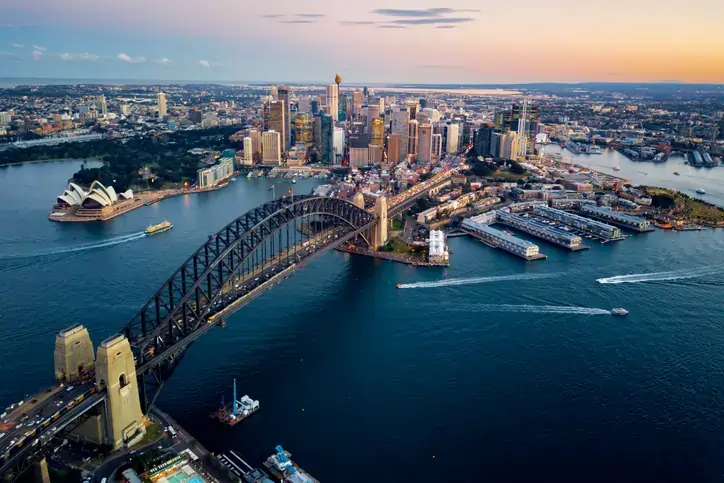
Digital Twin Technology Enables Port Authority of New South Wales to Actively Drive the Sustainable Development of the Blue Economy
Visualizing Assets Improves Operations and Helps to Develop Living Seawalls and Determine Sustainable Anchorage Locations
Managing a Chain of Ports
Port Authority of New South Wales manages numerous seaports along the southeastern coast of Australia. These seaports provide an array of vital services, ranging from cargo shipping that drives international commerce to cruise ship terminals that facilitate tourism. Beyond overseeing day-to-day operations, Port Authority also manages the movement of dangerous materials, emergency response, safety initiatives, and efforts to maintain or enhance the coastline environment and ecosystem. The result is a huge amount of assets interacting with each other, the environment, and outside organizations in a tangled web, even on uneventful days. To be responsible stewards of the Australian coast, Port Authority needed to carefully manage its assets.
Many Types of Data
Though Port Authority had transitioned to computer-assisted design years ago, team members usually worked in a 2D environment with static plans and maps. As technology advanced, the organization realized that a living digital twin could improve their understanding of the current state of all assets and the environment, helping them fine-tune operations at all their facilities and undertake new projects with a high level of confidence. Yet this digital twin had to incorporate a wide array of data. To succeed, it needed to assist with navigational safety, wind, wave, and current sensor management, tide gauge calibration, liaising with the Australian Hydrographic Office and the Bureau of Meteorology, and engineering surveys, just to name a few. Port Authority’s complex operations and diverse needs required digital twins with a high degree of sophistication.
Including It All in Digital Twins
Already familiar with Bentley applications, Port Authority determined that OpenCities applications would enable them to design the digital twins of the facilities and assets. First, they used OpenCities Map for GIS design, and tagged assets with detailed engineering data. They next published the information into digital twins with OpenCities Planner. Since the organization needed spatial context for the digital twins and could not rely on historical data, drones were used to capture fresh images of the sites and created 3D reality models with iTwin Capture Modeler. Finally, using OpenCities Planner to create an intelligent hub that any stakeholder could use to intuitively find any asset.
Undertaking Innovative New Projects
By visualizing all facilities and assets with digital twins, team members and stakeholders can obtain detailed information on all ports remotely, reducing the need for site visits while
improving collaboration and decision-making. Maintenance crews can familiarize themselves with sites and review safety protocols before visiting. The digital twins can be shared to external stakeholders which aids public understanding of the impact of port activities on the surrounding environment and fosters improved communication between teams and stakeholders. Port Authority is already using their enhanced knowledge of assets to help with innovative environmental initiatives, including sharing data to aid a project to identify locations for installing living seawalls that promote marine ecosystems. Another example is the plan to collaborate with fisheries, environmental agencies, and a local university to choose sites for 11 new anchorages that consider the impact on marine ecology and biodiversity. The inclusion of digital twin technology in the management of the Ports of New South Wales is contributing to the sustainable use of ocean resources to benefit the local economy, safety, livelihood, and ocean ecosystem health, actively driving the sustainable development of the blue economy.
Project Playbook: iTwin, OpenCities
Outcome/Facts:
- Visualizing Port Authority’s ports with digital twins helps stakeholders and the public understand the environmental impact of their operations.
- Enhanced knowledge of assets will help identify locations for installing living seawalls that promote marine ecosystems.
- Improved collaboration with fisheries, environmental agencies, and a local university helped determine the locations of 11 new anchorages that considered the impact on marine ecology and biodiversity.
Quote: “[The digital twins are] assisting us to achieve our Port Authority vision of One Team, One Port, One Culture.” – Belynda Gibbons, Senior Mapping Specialist, Port Authority of New South Wales
Image caption/courtesy 1 (header image): Visualizing Port Authority’s ports with digital twins helps stakeholders and the public understand the environmental impact of their operations. Image courtesy of Port Authority of New South Wales.
Author: Prathamesh Gawde, Senior Product Marketing Manager at Bentley Systems, focuses on marketing strategies and campaigns for Bentley’s building design software portfolio. Prathamesh is a certified digital marketing expert with rich experience and expertise in conceptualizing, developing, and implementing revenue marketing, digital marketing, account-based marketing, and demand-generation strategies and programs in a global and fast-paced corporate environment. Before joining Bentley Systems, Prathamesh held multiple marketing and business development positions with leading IT and engineering products/services companies. Prathamesh holds a master’s degree in management studies and a bachelor’s degree in engineering from the University of Mumbai. He can be reached at [email protected].
© 2023 Bentley Systems, Incorporated. Bentley, the Bentley logo, iTwin, iTwin Capture Modeler, OpenCities, OpenCities Map, and OpenCities Planner are either registered or unregistered trademarks or service marks of Bentley Systems, Incorporated or one of its direct or indirect wholly owned subsidiaries. All other brands and product names are trademarks of their respective owners.


